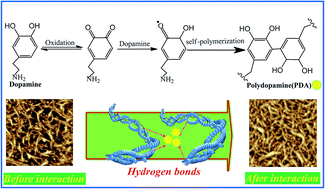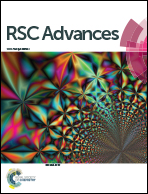Fabrication of a novel bio-inspired collagen–polydopamine hydrogel and insights into the formation mechanism for biomedical applications†
Abstract
The bio-inspired approach to the construction of hydrogels with both excellent biological properties and superior initiative adhesive ability to cells is a crucial intersection of the branches of biomaterials science and biotechnology. In the present work, a novel bio-inspired collagen–polydopamine (COL–PDA) hydrogel has been successfully fabricated via collagen self-assembly and the incorporation of PDA. Systematic FTIR and XRD analysis confirmed that the hydrogen bond interactions between collagen and PDA did not destroy the triple helix conformation of collagen which is mainly responsible for the good biological properties of the COL–PDA hydrogel. In comparison with a pristine collagen hydrogel, the physicochemical properties (i.e. porosity, swelling ratio and water holding capacity) of COL–PDA hydrogels could be tuned by modulating the extent of interaction between COL and PDA with the change of dopamine concentrations. The further analysis of AFM observation indicated that a higher dopamine concentration could interrupt the aggregation or self-assembly of collagen molecules into fibrils via the extensive self-polymerization process of dopamine. Furthermore, the formation of a fibrous network could also be controlled by the self-assembly of collagen through varying the dopamine concentration, thus to adjust the thermal stability, enhance the resistance ability to enzymatic degradation and further cause promoted chain entanglement and forming increased elasticity. In addition, owing to the combined biological properties of COL and PDA, fabrication of a bio-inspired COL–PDA hydrogel has significant potential for the development of novel collagen hydrogels with good biological property and initiative adhesive ability to cells in biomedical applications.


 Please wait while we load your content...
Please wait while we load your content...